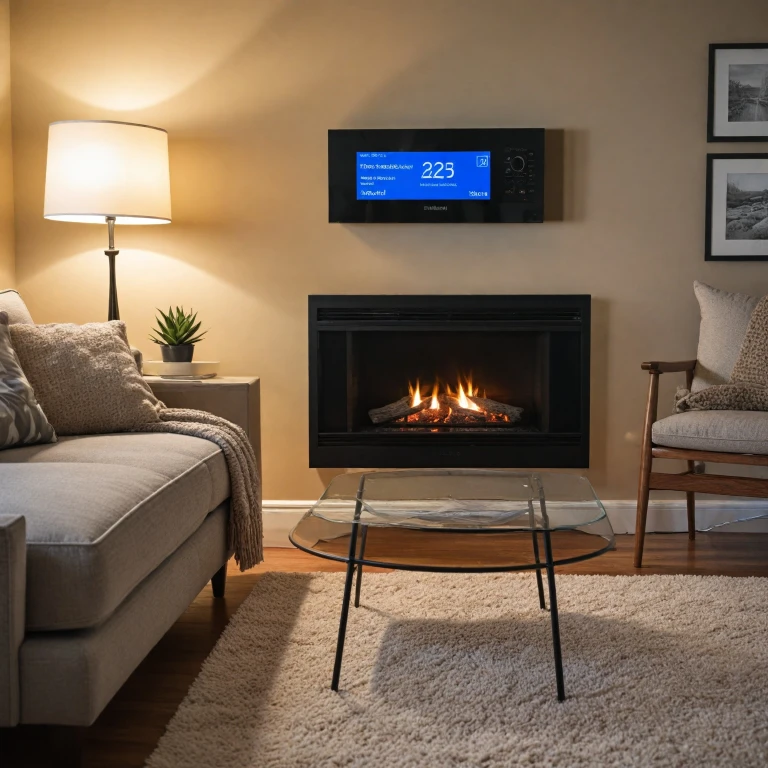Understanding Baseboard Heating Systems
Decoding the Mechanics of Baseboard Heating
Baseboard heating systems, often a mainstay in homes relying on electrical solutions, offer an efficient way to maintain warmth, particularly during those colder months. Unlike forced air systems, baseboard heaters work through convection to circulate warm air, making them a staple in many residential settings. They come in two varieties: electric baseboard heaters and hydronic water-based models.
Electric baseboard heaters are quite prevalent due to their simplicity and direct connection to the electrical grid. Each heater contains a heating element that warms the air as it circulates over it. These systems are typically managed by voltage thermostats, which can either be single pole or double pole. The single pole option provides a basic on/off capability, while the double pole thermostat offers a more nuanced range of control.
To delve deeper into the specifics, these heaters consume electricity through a dedicated circuit, making it essential to choose the right smart thermostat to optimize usage efficiently. Depending on the heater's wattage and your home's wiring setup, compatibility assessments are crucial before investing in a smart thermostat for baseboard systems. Understanding the voltage requirements, such as whether you need a 208V or 240V setup, is equally important to ensure seamless integration.
For those already using programmable thermostats, the switch to a smart thermostat promises enhancements not only in convenience but also in energy savings, offering more precise control over home heating. Solutions like the Mysa smart thermostat or Honeywell Aube models are popular among homeowners looking for a modern upgrade.
Overall, integrating smart thermostats with baseboard heating systems presents a promising avenue for optimizing comfort and cutting down on energy expenses. Learning about the benefits of a two-stage thermostat can provide further insights into enhancing your system's efficiency
Learn more about the benefits of a two-stage thermostat. As we explore further into the role of smart thermostats, understanding these core mechanics will lay the groundwork for improved performance and user satisfaction.
The Role of Smart Thermostats in Baseboard Heating
Integrating Smart Control with Baseboard Heat
The emergence of smart thermostats has revolutionized how we manage our household heating systems, particularly for those relying on electric baseboard heaters. Unlike traditional thermostats, smart models offer advanced programmability, enabling users to set precise temperature schedules that align with their lifestyle needs, ultimately optimizing comfort and efficiency.
Electric baseboard heaters have unique requirements compared to other heating systems, primarily due to their specific voltage requirements and the way they distribute heat. Smart thermostats designed to interface with baseboard heaters come equipped to handle high voltage lines, such as the voltage thermostat models, ensuring safety and efficiency.
Enhancing home comfort with smart thermostats requires understanding how these devices interface with your existing baseboard heating system. Smart thermostats, such as those offered by Mysa and Honeywell, are designed to manage single pole or double pole circuits, which are commonly found in electric baseboard heating setups.
Programmable thermostats allow homeowners to customize heating schedules easily. By installing these smart devices, users can remotely control each heater or a group of heaters, providing a more personalized heating experience. Advanced products like the Mysa smart thermostat offer features such as overheat protection, preventing damage to the baseboard heaters and potential hazards.
Pricewise, smart thermostats range significantly. However, investing in a high-quality product can offer significant savings on energy bills by efficiently regulating energy use in response to occupancy and preferences.
The stars of smart thermostats, such as Honeywell Aube, accentuate efficient energy management and convenience. With white thermostat models blending seamlessly into any interior, they become a subtle yet powerful tool in managing electrical consumption and comfort in your home.
In conclusion, with smart thermostat technology, the potential for elevated home comfort and control is evident, bridging the gap between traditional heating methods and modern smart innovations.
Challenges of Using Smart Thermostats with Baseboard Heating
Overcoming Hurdles in Smart Thermostat Integration
Integrating smart thermostats with baseboard heating systems presents unique challenges. Below, we examine these obstacles and propose potential solutions.
Baseboard heaters, favored for their simplicity and efficiency in electric heating, often employ a straightforward single or double pole wiring configuration. This creates a challenge when integrating modern smart thermostats, originally designed for centralized HVAC systems.
- Wiring Compatibility: Traditional thermostat wiring can be incompatible with the high voltage typically used for baseboard heaters. Smart thermostats like Mysa or some Honeywell models are crafted to bridge this gap, offering compatible heating control while aligning with standard wiring.
- Voltage Requirements: Electric baseboard heaters necessitate thermostats that can manage higher voltage loads. Ensuring your smart thermostat can handle such voltage—whether a 120-volt or 240-volt system—is crucial.
- Temperature Control Precision: Baseboard systems heat spaces differently from forced-air systems. Therefore, smart thermostats must be equipped to manage this with precision to prevent overheating.
- Programmable Features: The efficacy of devices like the Honeywell Aube depends significantly on its programmable capabilities, which adapt heating conditions without manual intervention, reducing energy consumption and saving on heating costs.
Understanding these challenges is vital for optimizing comfort with smart thermostats in baseboard heating environments. For further insights, consider exploring additional resources on smart thermostat applications.
Key Features to Look for in a Smart Thermostat for Baseboard Heating
Essential Considerations for Choosing a Thermostat
When selecting a smart thermostat for your baseboard heating system, there are several key features and factors to consider that can significantly impact the effectiveness and efficiency of your setup.
Compatibility and Voltage Requirements
First and foremost, ensure that the smart thermostat is compatible with electric baseboard heaters. This often requires checking the voltage requirements. Your baseboard heater might demand a voltage thermostat capable of handling either single pole or double pole configurations. This compatibility ensures seamless integration and optimal temperature control.
Programmability and Remote Control
Programmable thermostats offer significant advantages by allowing users to set schedules tailored to their routines, which can lead to energy savings. Brands like mysa smart thermostats are renowned for their user-friendly programmable features. Furthermore, having remote control capabilities adds an extra layer of convenience, enabling temperature adjustments from virtually anywhere.
Overheat Protection and Safety Features
Safety should never be compromised. Look for thermostats that offer overheat protection to prevent damage to your heaters or, worse, risk to your home. This feature provides peace of mind, especially for electric baseboards which can reach high temperatures.
Cost-Effectiveness and Energy Efficiency
Price considerations do not solely revolve around the initial purchase cost. Evaluate the product on potential energy savings over time. Energy-efficient thermostats can dramatically reduce heating bills. A good review of options like honeywell aube thermostats can highlight models that offer substantial savings.
Installation and User Experience
Ease of installation is another factor. Some smart thermostats need additional hardware or specific wiring (like a neutral wire), which could require professional installation. Once installed, ensure the interface is intuitive. A sleek thermostat design, such as a thermostat white finish, complements aesthetics while remaining functional and easy to use.
In summary, while navigating through different products, consider these vital aspects to ensure that your baseboard heating system is not only efficiently managed but also aligns with your comfort preferences.
Case Studies: Successful Integration of Smart Thermostats with Baseboard Heating
Real-World Applications of Smart Thermostats in Baseboard Systems
The integration of smart thermostats in electric baseboard heating systems is gaining traction, showing impressive results in enhancing comfort and energy efficiency. Let's look into some scenarios where these smart devices have proved their worth.
One successful application involves the use of programmable thermostats like Mysa. By allowing users to control temperature settings remotely, Mysa smart thermostats have shown significant energy savings in households relying on baseboard heaters. With its compatibility with single pole and double pole voltage systems, Mysa can effectively manage voltage fluctuations, ensuring optimal performance of baseboard heaters.
Furthermore, homeowners have experienced enhanced comfort levels by utilizing products from brands like Honeywell. These smart thermostats provide precise control over heating schedules, helping to avoid the common issue of overheat protection. By setting a programmable thermostat to align with daily routines, consumers have reported a noticeable reduction in energy consumption and associated costs.
In another case, integration of smart thermostat models such as Honeywell Aube, that come with advanced features like white stars interface and voltage thermostat control, have allowed users to seamlessly manage heater thermostats based on real-time data analysis. This adaptability, alongside the ease of installation with existing thermostat wire configurations, makes them a highly recommended option for managing electric baseboard heating systems.
Across different setups, the dual integration of efficient, high-performance thermostats with traditional heating systems highlights the importance of selecting appropriate smart thermostats tailored to electric baseboards. These practical applications not only signify a leap forward in technology adoption but also suggest a growing trend towards more sophisticated heating solutions that prioritize both comfort and energy savings.
Future Trends in Smart Thermostats and Baseboard Heating
Exploring Upcoming Innovations in Baseboard Heating and Smart Controls
The evolution of smart thermostats in the realm of baseboard heating has gained momentum, promising a wealth of advancements catering to consumer demands for efficiency and convenience. Upcoming trends suggest continued integration of technology with everyday appliances, focusing on energy efficiency and user-friendly control mechanisms.
As smart thermostats, including popular models from Mysa and Honeywell, become a standard in home heating systems, manufacturers are pointing towards products that can self-learn usage patterns. These devices analyze room occupancy and adjust temperatures accordingly, contributing to energy savings and enhanced comfort.
Emerging features include enhanced compatibility for both single pole and double pole systems, which are characteristic of electric baseboard heaters. These advancements are set to simplify the installation and usage process, offering seamless integration with existing heating setups.
Many smart thermostats are also venturing into integrating artificial intelligence for predictive maintenance alerts. This includes notifying users when baseboard heaters are at risk of overheat protection failure or other issues, ensuring the longevity and safety of heating appliances.
Voltage adaptability is another key area of innovation. As homes vary widely in their electrical setups, the introduction of voltage thermostat models that automatically adjust to match home wiring will make installations more straightforward and diminish compatibility concerns.
Furthermore, the user interface of smart thermostats is being refined to enhance ease of navigation. Many companies are opting for sleek, touch-sensitive designs in thermostat white finishes. These ensure an aesthetic fit in modern homes while still offering full programmable control over heaters.
With more households seeking eco-friendly options, the upcoming smart thermostat designs emphasize not just in design but also in operation, offering high-energy star ratings and allowing customers to monitor and reduce their carbon footprint effectively. This integration aids in heat management without the need to compromise on comfort or style.
As these smart products become more readily available, attention is also turning towards affordability. The price points are anticipated to become more competitive, enabling even more households to access the benefits of programmable thermostats without straining their budgets.
The future of smart thermostat technologies in homes with baseboard heating suggests a move towards fully integrated smart home systems. As the developments unfold, consumers can expect a significant enhancement in home heating solutions, ensuring comfort, efficiency, and reliability in every product iteration.

